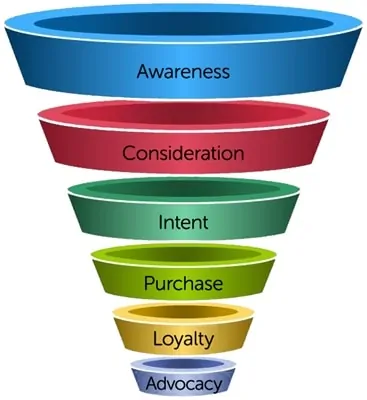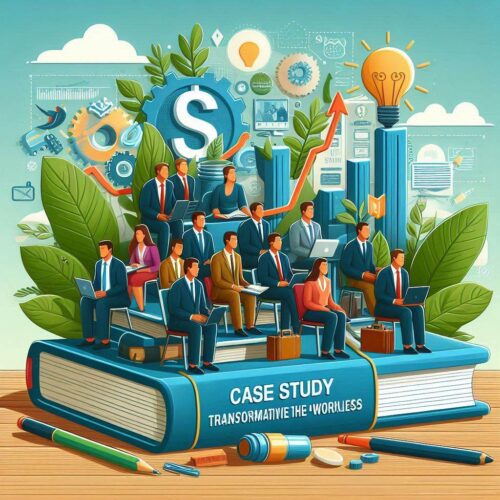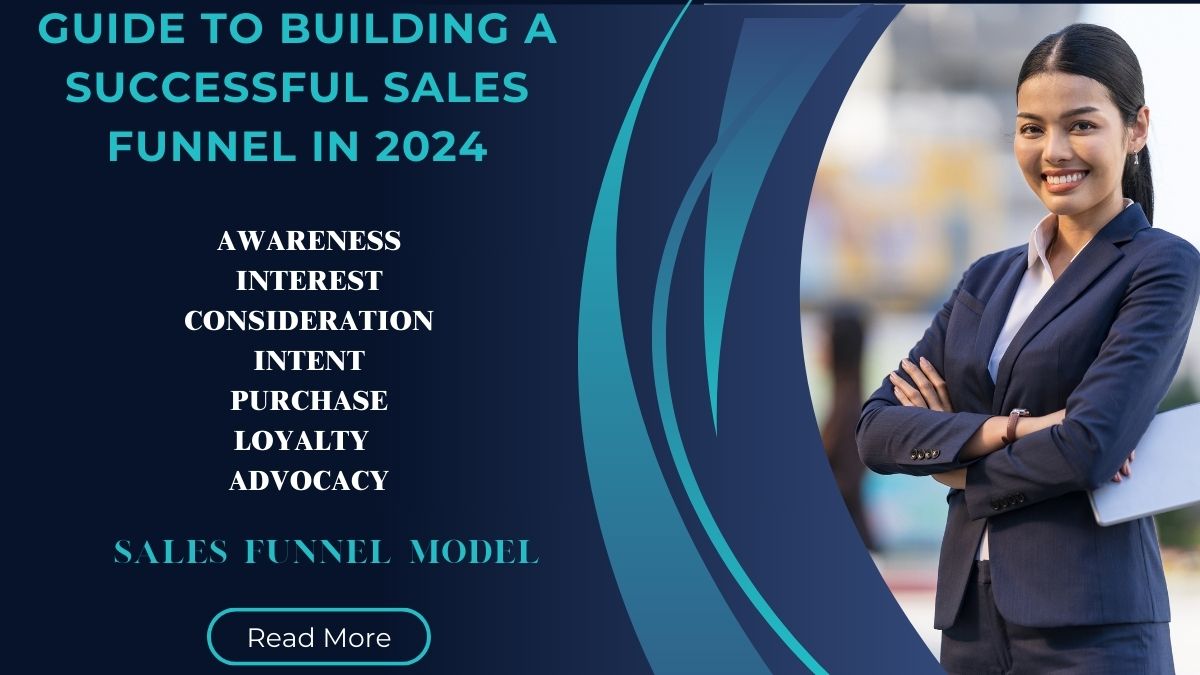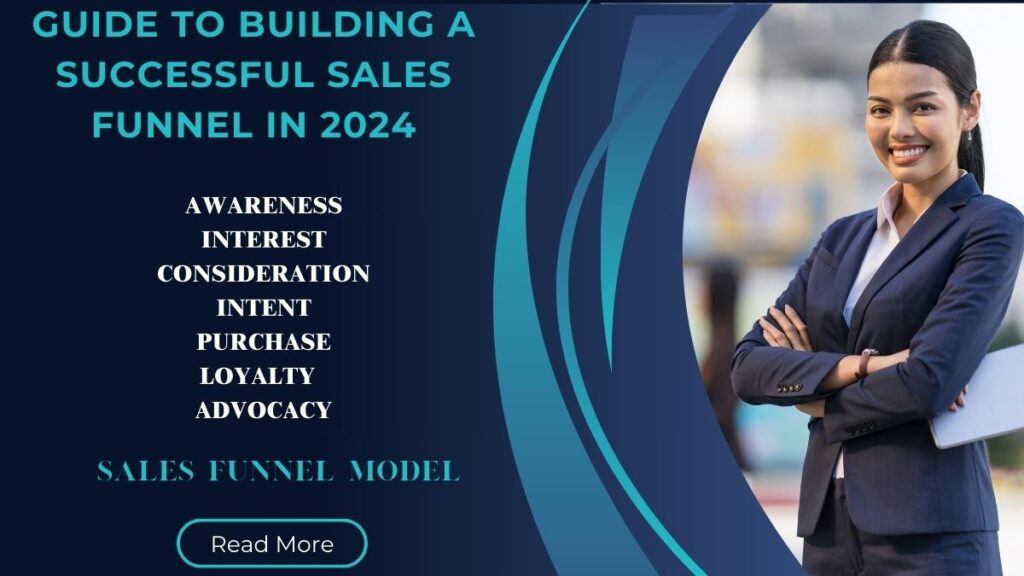Today, I will guide you to building a successful sales funnel in 2024—a crucial component for any business looking to thrive in a competitive market. But this isn’t just about what a sales funnel is; it’s also about how you can construct one that not only brings in leads but effectively turns them into loyal customers.
What Is A Sales Funnel?
A sales funnel is a model that outlines the journey potential customers take from first becoming aware of a product or service to making a purchase and beyond. It helps businesses visualize and optimize the customer acquisition process by breaking it down into several key stages:
- Awareness: This is the initial stage where potential customers learn about your product or service. Marketing activities like advertising, social media, and SEO aim to attract a broad audience and generate interest.
- Interest: At this stage, those aware of your product seek more information. Engaging content, email newsletters, and informative blog posts are used to capture and maintain their interest, turning passive awareness into active engagement.
- Consideration: Prospects begin evaluating whether your product or service meets their needs. Providing product demos, case studies, and customer reviews can help persuade them that your offering is the best solution for their problem.
- Intent: Prospects intend to buy, often by adding items to a cart or signing up for a trial. Personalized offers and detailed product information can help move them closer to purchasing.
- Purchase: This is the stage where the prospect makes the actual purchase. Ensuring a smooth transaction with a simplified checkout process, multiple payment options, and post-purchase support can enhance the customer experience.
- Loyalty and Advocacy: The goal is to turn customers into repeat buyers and advocates after the purchase. Excellent customer service, loyalty programs, follow-up emails, and referral incentives help foster long-term relationships and generate word-of-mouth referrals.

The sales funnel model helps businesses identify and address potential drop-off points, personalize marketing efforts, and measure the effectiveness of their strategies to improve conversion rates and build stronger customer relationships.
A Successful Sales Funnel Is The Engine Of Your Business;
Throughout this guide, I will provide clear and actionable steps for building a robust sales strategy anchored by a well-designed sales funnel.
Let’s start with a simple truth: your sales funnel is the engine of your business machine, pumping vitality into every sales process and driving potential customers toward conversion.
To construct a strong sales funnel, you must grasp the underlying principles that make it work.
This includes understanding the buyer’s journey and ensuring that each stage of your funnel aligns with the customer’s decision-making process.
But don’t worry too much about getting overwhelmed. I’ll break down each stage, from attracting prospects to making a sale and then retaining those customers for the long haul.
These insights will flow seamlessly into the next component of the guide, which is knowing your audience.
After all, the success of your sales funnel is directly tied to how well you understand and can anticipate the needs and behaviors of your potential clients.
Understanding Your Audience: The Foundation of a Strong Sales Funnel
In my opinion, nailing down who your customers are is pivotal. Your entire sales strategy hinges on getting this first piece right. So, let’s talk about customer profiles and personas.
These aren’t just buzzwords; they’re powerful tools that can dictate the direction of your sales funnel.
First, you need data—and lots of it. Surveys, interviews, and market research are your best friends here. You’re looking for patterns, preferences, and pain points.
It might seem like a lot, but trust me, the insights you gain are pure gold for making informed decisions.
Once you’ve got the data, it’s time to get analytical. Think of yourself as a detective, piecing together the profile of your ideal customer.
Age, location, interests—these details will shape how you communicate with your audience.
And it doesn’t stop with demographics. Psychographics play a significant role, too. Understanding attitudes, aspirations, and lifestyles can help you align your funnel stages perfectly with your customers’ expectations and experiences.
Armed with a deep understanding of your audience, you’ll be ready to lure them into the opening of your funnel. That’s where we’ll go next – the Attraction Phase. This is all about drawing in those well-understood potential leads with the right bait.
The Attraction Phase: Capturing Potential Leads
This section will explain the critical first contact with potential customers, the ever-important attraction phase. This is not just about getting their attention; it’s also about ensuring that you’re attracting the right kind of prospects.
Content marketing and search engine optimization (SEO) are your best friends here. I’ll explain how quality content that answers real questions can attract your audience.
We’ll also explore why optimizing for search engines can make your content discoverable when your audience needs it most.
Social media can’t be ignored either. It’s where conversations happen and brands get noticed. I’m here to help you understand how to leverage these platforms and the types of advertising that can amplify your Reach.
And what’s a lead magnet? Think of it as a tasty appetizer that lures people to your table. You can constantly adjust your approach, but choose something that resonates with your audience initially.
This could be an informative ebook, an exclusive webinar, or even a discount on their first purchase.
Of course, each lead magnet should have a clear call to action (CTA). A strong CTA moves people along your sales funnel, inching them closer to becoming paying customers.
We aim for that in the attraction phase—a seamless transition that guides potential leads from discovering your brand to being ready to hear more.
Conversion Optimization: Nurturing Leads into Customers

Now you’ve got their attention. Potential leads are coming in, and that’s a big win! But this isn’t just about getting leads; it’s also about turning them into paying customers. This is where the art of conversion optimization comes into play.
First, let’s discuss email marketing. It’s still one of the most effective tools for engaging potential customers.
Regular, valuable emails can help build relationships and trust, eventually leading to a sale. It’s all about timing and relevance. Who will ignore an email that feels it’s been tailor-made for them?
Now, the buying process must be as clear as crystal. Confusion is the enemy of conversion. Make sure each step is simple.
Any snag in the process could mean a lost sale, so go through it yourself or watch someone else go through it. Address any hiccups immediately.
Here’s where A/B testing becomes your best friend. It allows you to compare different versions of your webpage, email, or any other customer touchpoint to see which performs better.
It’s like having a crystal ball that tells you which changes will lead to more sales.
Remember, your first attempt at building a sales funnel won’t be your last. Continuously optimizing and refining the conversion aspect of your funnel will lead to a more effective sales process.
From there, you’ll want to consider how to build lasting relationships with customers post-sale, which leads us nicely into the retention and referral stage.
Retention and Referral: Maximizing Customer Value
Okay, you’ve got customers streaming through your sales funnel and converting—that’s a solid win. But here’s where the game changes: long-term success relies on retention and referrals.
A one-time buyer can be good for a quick boost, but a repeat customer brings more stable revenue and can also become a brand ambassador who attracts new leads.
Here’s a knockout truth: loyal customers are often the best source of new business. Post-purchase interaction can make or break this loyalty.
Simple thank-you notes, satisfaction surveys, or even personalized offers can go a long way in keeping your brand at the forefront of your mind.
Ever wonder how powerful a customer’s opinion can be? Encouraging feedback is like unlocking a goldmine; positive reviews and testimonials can attract future buyers.
And for the cherry on top, set up a loyalty program. This is more than just a perk—it’s a way to make customers feel valued and incentivize them to spread the word about your fantastic product or service.
I’m not suggesting you become a pushy salesperson waving referral discounts like a flag.
Instead, find authentic and value-adding ways to encourage customers to share their positive experiences. Maybe it’s a referral discount, exclusive content, or early access to new products.
Ultimately, the best sales funnels aren’t just a path to purchase; they’re a cycle. A cycle that keeps rolling by transforming customers into advocates and repeating the process.
Invest in the retention and referral stages and watch how that money returns to the beginning of your funnel, powering your business forward.
Remember: A successful sales funnel doesn’t stop at the purchase; it starts anew with each customer interaction. So keep fine-tuning, stay authentic, and value your customers like the VIPs they are. Do that, and you’ll ride the wave of today’s success and shape tomorrow’s opportunities.
Personal Case Study: Building a Successful Sales Funnel for an E-commerce Store

Background
I recently optimized the sales funnel for an e-commerce store specializing in eco-friendly home goods. The store had decent traffic but struggled with low conversion rates and high cart abandonment.
Step-by-Step Process
1. Awareness Stage: Expanding Reach
Initial Challenge: The store had a moderate online presence but was not reaching a broad audience.
Actions Taken:
- Implemented a comprehensive content marketing strategy, including blog posts about sustainable living and eco-friendly products, guided by the Wealthy Affiliate training on content creation and SEO.
- I’ve implemented a comprehensive content marketing strategy, including blog posts about sustainable living and eco-friendly products.
- Launched targeted social media campaigns on platforms like Instagram and Facebook, focusing on visually appealing and educational content.
- Utilized Google Ads and Facebook Ads to target environmentally-conscious consumers.
Results: Traffic increased by 50% within three months, and social media engagement and website visits significantly increased.
2. Interest Stage: Engaging Prospects
Initial Challenge: Visitors left the site quickly without exploring the products.
Actions Taken:
- It has enhanced the website with engaging and informative content, including videos demonstrating product use and benefits.
- I have added a newsletter sign-up form with an incentive (10% off on the first purchase).
- Also created an automated email sequence to nurture new subscribers, featuring educational content about sustainability and product benefits.
Results: Newsletter sign-ups increased by 35%, and email open rates averaged 45%, indicating strong engagement.
3. Consideration Stage: Persuading Potential Buyers
Initial Challenge: Visitors hesitated from browsing to adding items to their cart.
Actions Taken:
- I’ve introduced detailed product descriptions, high-quality images, and customer reviews.
- Offered live chat support to answer any questions in real time.
- Published case studies and testimonials from satisfied customers.
Results: The average time spent on product pages increased by 40%, and the number of products added to carts grew by 30%.
4. Intent Stage: Encouraging Purchase Intent
Initial Challenge: High cart abandonment rates indicated issues at the intent stage.
Actions Taken:
- Implemented exit-intent popups offering a special discount for completing the purchase.
- Send automated cart abandonment emails with personalized messages and incentives to complete the purchase.
- We have streamlined the checkout process by reducing the number of steps and adding multiple payment options.
Results: Cart abandonment decreased by 25%, and the conversion rate from cart to purchase increased by 20%.
5. Purchase Stage: Ensuring Smooth Transactions
Initial Challenge: Some customers experienced issues during checkout, leading to lost sales.
Actions Taken:
- Tested and optimized the checkout process to ensure it was smooth and user-friendly.
- I added clear, upfront information about shipping costs and delivery times.
- I have provided multiple customer support channels (live chat, email, phone) to assist with any issues during checkout.
Results: The conversion rate improved by 15%, and customer satisfaction scores for the checkout process increased significantly.
6. Loyalty and Advocacy Stage: Fostering Repeat Business
Initial Challenge: Limited repeat purchases and low customer advocacy.
Actions Taken:
- I launched a loyalty program that offers points for every purchase, which can be redeemed for discounts or free products.
- Also sent personalized follow-up emails after the purchase, including care tips for products, additional product recommendations, and exclusive offers.
- Encouraged satisfied customers to leave reviews and refer friends by offering referral bonuses.
Results: Customer retention rates increased by 30%, and the referral rate grew by 20%. Positive reviews on the website and social media also significantly rose.
We significantly improved the store’s overall performance by systematically addressing each sales funnel stage. Traffic increased, engagement levels soared, conversion rates improved, and customer loyalty strengthened.
This holistic approach ensured a smoother, more satisfying customer journey, leading to better business outcomes.
Building a successful sales funnel requires understanding and addressing the unique challenges at each stage, constantly testing and optimizing strategies, and maintaining a customer-centric approach.
Conclusion On Guide To Building A Successful Sales Funnel In 2024
Building a successful sales funnel is crucial for converting leads into loyal customers.
By understanding each stage of the funnel—awareness, interest, consideration, intent, purchase, and loyalty—you can systematically address challenges and optimize your strategies.
In my case study with an e-commerce store, we saw remarkable improvements by enhancing content, engaging prospects, providing detailed product information, simplifying checkout, and fostering customer loyalty.
Traffic increased, engagement levels soared, and conversion rates improved significantly.
I encourage you to share your experiences and insights in the comments below. How have you optimized your sales funnel?
Let’s learn from each other’s successes and challenges. If you find this guide helpful, please share it with your network and leave any questions in the comments box below!
Earl


What an amazing specific, straight-to-the-point, no-fluff explanation of the sales funnel. I have never seen such an elaborate and straight-to-the-point description.
The icing came with the beautifully organized case study. Although I don’t have my own products to sell, but your article made me think of each post that I make to my diary.
Until now I am still struggling to get organic traffic. I was unhappy with the small number of search impressions. Now I have zero search impressions.
I used to get much more traffic in the past when my domain was a free WordPress domain. Still, that was years ago. I don’t know what kind of traffic will I be getting today if I repeat that trial of a free WordPress domain.
Thank you so much for your kind words! I’m thrilled to hear that you found the explanation of the sales funnel and the case study so helpful and well-organized. It’s great to know that it resonated with you, even if you aren’t currently selling products.
Regarding your struggle with organic traffic, it’s common to face these challenges, especially with changes in domain status and search algorithms over the years. Here are a few tips that might help you improve your search impressions:
SEO Optimization: Make sure your content is optimized for search engines. This includes using relevant keywords, meta descriptions, and alt tags for images.
Quality Content: Continue to produce high-quality, engaging content that provides value to your readers. Consistency is key.
Backlinks: Build quality backlinks to your site from reputable sources. This can significantly boost your domain authority and improve search rankings.
Social Media Promotion: Leverage social media platforms to share your content and drive traffic to your site.
Technical SEO: Ensure your website is technically sound. This includes having a mobile-friendly design, fast loading times, and secure connections (HTTPS).
Returning to a free WordPress domain might not provide the same level of control and professional appearance as a custom domain, but it could be worth experimenting with if it previously worked for you.
Keep experimenting and refining your strategy, and don’t get discouraged. Organic traffic can take time to build, but with persistence and the right techniques, you can achieve your goals. Good luck!
Earl
I think it’s easy for people to forget how important it is to nurture each step in the sales funnel. The most important is interest. Your great case study shows that, their website didn’t keep/get their interest quick enough for them to even look around. Then I think people just forget about their customers after they get the sale. Not realizing how much money can come from just that one person. Not only with them buying on a regular basis, but telling others about the product. I am more inclined to buy when I hear about it from someone I know and trust. Thanks for a great article.
Thank you for your thoughtful comment!
You’ve highlighted a crucial aspect of sales and customer relationships – nurturing each sales funnel step is essential.
As the case study you mentioned demonstrated, it’s important to capture and maintain customer interest from the very beginning.
Additionally, post-sale engagement and customer retention are often underestimated but can lead to ongoing sales and incredibly valuable positive word-of-mouth referrals.
I’m glad you found the article helpful, and I appreciate your insights on the power of trusted recommendations in making purchase decisions.
Thanks again for your kind comments.
Earl
This post has shown me everything that I need to know about building a successful sales funnel. I knew nothing about sales
funnels were. Until I read some articles about Internet Marketing. Ed’s post suggested that a properly built sales funnel
can be the backbone of a business’s Internet Sales Strategy.
His post breaks down a sales funnel in to different stages. He explains how each stage works. And, how each stage should
align with the target customer’s decision-making process. Ed repeats the importance of determining who your target
customer is, and where to find them.
He tops all of this information about sales funnels off with a case study. This study shows the different stages of the
sales funnel. The study also shows potential problems within each stage. And, the possible remedies.
Isn’t this post a great example of how to use a relevant case study to summarize all of this information? The case study
also shows how the different stages of a funnel work together.
Thank you for a very informative post…